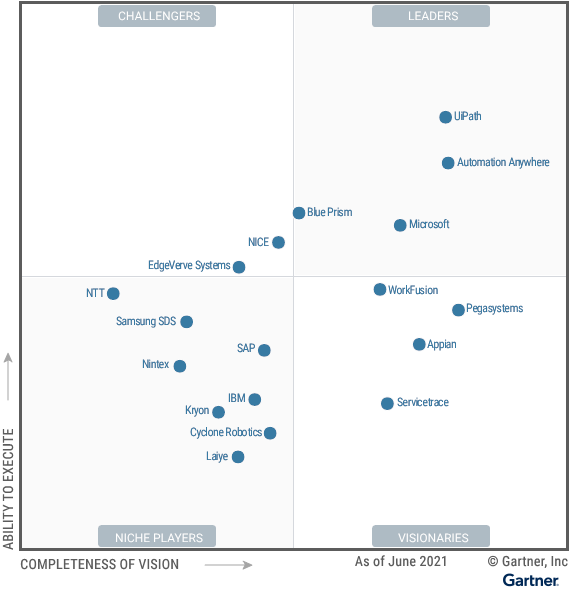
As it does every year, Gartner, an advanced technology research and advisory firm, proposes its “Magic Quadrant”, a table that takes the form of four boxes, each corresponding to a category: leaders, visionaries, niche players and challengers. The document proposed by Gartner can concern any of the 100 technological sectors that the firm is looking at. Today, we’re going to look at the Robotic Process Automation (RPA) Magic Quadrant that Gartner proposed last month.
What is the Gartner Magic Quadrant
The Gartner Magic Quadrant provides an in-depth analysis of the players in a technology sector. At a glance, it is able to understand in which category a company falls thanks to a visual aspect in the form of a graph or table. Based on their scores on the two axes (Ability to Execute, Completeness of Market Understanding and Vision) that the quadrant comprises, companies fall into one of the following four boxes:
- Leaders in the Magic Quadrant are those companies that combine excellent market insight with the ability to execute. This is the position that the companies cited by Gartner covet.
- Visionaries are companies that have excellent market vision or want to change the rules of the market but are not yet executing well enough to be in the leadership slot.
- Niche players are players that focus on a specific market segment, have the ability to execute and a market vision that is behind their competitors.
- Challengers have a strong ability to execute and dominate a large segment of the market while lacking market vision.
Several elements are taken into account to rank companies such as the functionality of their solutions, financial results, efficiency of customer support, ability to anticipate market changes, communication; sales performance, ability to include customer demands within its offering, business model, ability to address specific market segments or geographical implementation.
What is a good robotic process automation platform
According to Gartner, RPA tools must offer several fundamental capabilities, namely:
- Enable citizen developers to create automation scripts
- Ability to integrate with enterprise applications, primarily via user interface scraping
- Have orchestration and administration capabilities, including configuration, monitoring and security
However, it considers that companies gain an edge if their platforms have one or more of the following features:
-
Intelligent document processing
-
Machine learning and NLP libraries with drag-and-drop models
-
Process extraction and discovery
-
API connectors that can be orchestrated with UI scrapers
-
Low-code user experience (UX) to create UI front ends for bots
-
Headless or serverless orchestration of automation workflows (also described as “headless bots”)
Gartner Magic Quadrant for Robotic Process Automation Overview
Below, find the Gartner Magic Quadrant for RPA:

Let’s focus on each category by taking the example of a player in each box of the table:
- Leaders: leaders include tech giant Microsoft, but also UiPath, whose platform of the same name offers, according to Gartner, a wide range of governance features, a very user-friendly user experience, enhanced computer vision, and orchestrated RPA in Cloud as a Service (CaaS).
- Visionary: Appian is one of those companies considered visionary by Gartner. Its flagship product that runs as a cloud service, Appian RPA, stems from the acquisition of the Jidoka RPA platform from Novayre Solutions in January 2020. Its solution focuses on augmenting and interacting with sophisticated processes, such as those involved in end-to-end case management.
- Niche Players: there are two technology giants in this category. Firstly, the American IBM, with IBM Robotic Process Automation, resulting from the acquisition of WDG Automation in June 2020, provides a broad portfolio of RPA functionality even if not complete. However, its offering and marketing strategy are far from being perfected. Then there is Samsung SDS, whose RPA product includes a conversational AI platform with native ML and RPA-as-a-service capabilities.
- Challengers: EdgeVerve Systems is placed in the challenger slot in the Magic Quadrant. The company offers the AssistEdge solution which includes a unified automation platform that is suitable for large enterprises. In the future, the company wants to extend the functionality of its platform with low-code workflow, fault detection algorithms, automated repair bots, predictive analytics and recommendations.
Translated from Gartner : quelles entreprises du marché de l’automatisation robotisée des processus ont pris le pas sur leurs concurrents?









